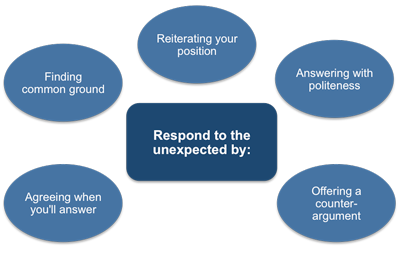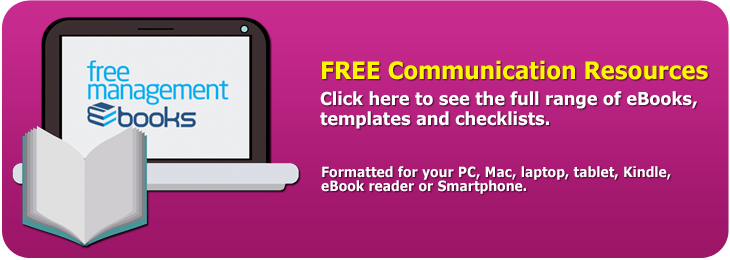Communication Skills - Retaining Control in a Presentation
Assuming that you have confidence in the material that you are presenting and have practiced it sufficiently then nervousness should not be too much of a problem.
 |
One of the best ways to ensure you remain in control is to do everything you can to either preempt or prepare for questions that undermine your position or message, or that you simply cannot answer. An unexpected question has been known stop a previously convincing speaker dead in their tracks. You can never be 100 percent certain this won't happen, but through careful planning and rehearsing you can attempt to minimize the possibility.
If an unexpected disruption occurs you have three options open to you:
- Simply reiterate your position as firmly and confidently as possible
- Acknowledge the question. saying that there is insufficient time to answer it properly now, but that you will do so in the question and answer session
- Respond directly to the challenge with some sort of counter-argument
The first option carries the risk of making you appear arrogant and is best avoided even if you think that the person asking the question has very little support among the audience.
The second option is usually the best one. Make sure that you take the time to note down the question, who asked it (name, title, division, or organization), and at which part of your presentation it occurred. If the question cannot be answered during the Q&A session you may want to give the person an indication of when you will get back with your response.
Responding directly to the challenge with a counter-argument can be a very dangerous tactic because you will not have prepared a response and you could easily end up in a lengthy standup squabble.
You should also avoid the temptation to let a colleague answer a question because this would be one of the easiest ways for you to lose your credibility and control. You also have no idea what that person may say in their answer and therefore have no way to judge its impact on your key message statement. So unless you are 100 percent confident that their answer will support your aim then noting the question and agreeing to answer it later is the best option.
The key things to remember when dealing with a disruption are that you must be polite but firm, and you must never lose your temper - if you enter into a shouting match with a heckler then they win and you lose.
It is vital you don't let disruptive members of the audience derail your presentation - your time is limited so don't get involved in protracted discussions. Try to approach the point of contention from any common ground that you share. If this fails to work then politely request that the point is discussed later at the pre-planned question and answer session.
If someone criticizes something that you have said, avoid getting into an argument with them. If your point was based on fact then make this clear and present the evidence. However, if it was based on your personal opinion, then don't attempt to pass this off as factual. Always remember that what is underlying the point of contention may be a genuine concern and you should be seen to at least acknowledge this. If you try to brush it aside it might be taken up by other members of the audience and could become a much bigger issue than if you had simply recognized it in the first place.
Attention seekers may make silly or sarcastic comments simply to get themselves noticed. Others may respond unwittingly to a rhetorical question that you have posed simply because they weren't paying full attention!
Try to analyze these sorts of events as they occur and respond, perhaps with humor, acknowledgement, or support but don't try to put people down - this nearly always reflects badly on the presenter.
You may also be interested in:
Giving a Management Presentation | Styles of Presenting | Cue Card Guidelines | Developing a Persuasive Delivery Style | How to Rehearse | Reading Your Audience | Question and Answer Session | Importance of the Presentation Venue | Presentation Venue Layout.



